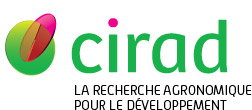Poeydebat Charlotte, Carval Dominique, De Lapeyre de Bellaire Luc, Chabrier Christian, Vargas Randall, Daribo Marie Odette, Rodriguez Arias Ignacio, Tixier Philippe.
2016. Multiple pests' ecological control driven by plant richness in banana agrosystems.
|
Version publiée
- Anglais
Utilisation soumise à autorisation de l'auteur ou du Cirad. 611966.pdf Télécharger (109kB) | Prévisualisation |
Résumé : Agricultural intensification has led to vegetation simplification and reliance upon phytosanitary products as pest damage became the main contributor to yield losses. Detrimental impacts of pesticides upon health and environment have raised interest for alternative sustainable pest management. Agroecosystem plant diversification may restore ecological pest regulation by modifying the micro-climatic conditions, the diversity and availability of resources and the diversity and fragmentation of habitats. These changes potentially affect life cycles and dispersion of pests and of biological control agents, and food webs. The complexity of ecological interactions in diversified agroecosystems and the multiplicity of pests to which a crop is exposed make the implementation of diversification a challenging objective. A trade-off has to be found between multiple pests' regulation accounting for antagonistic regulation processes and the interaction of damage types at the physiological scale. Using clonal phytometers located in plots distributed along a gradient of plant diversity ranging from monoculture to traditional agroforestry fields, we aimed at determining the factors involved in the regulation of the three main pests of bananas: the banana weevil, Cosmopolites sordidus, the causal agent of black sigatoka, Mycosphaerella fijiensis, and the main plant-parasitic nematodes species, Radopholus similis, Pratylenchus coffeae, Helicotylenchus sp. and Rotylenchulus reniformis.We measured crop biomass production and pests' abundances and damages on each phytometer banana plant. As potential regulatory factors, we measured soil properties, plant diversity and structure, and abundances of trophic groups of soil nematodes' and litter arthropods' communities. Using structural equation modeling, we determined for each pest the relationships between i) between vegetation characteristics and regulatory factors, ii) between regulatory factors and pest abundance and damage, and iii) between injury profiles and crop production. Above ground, low plant species richness and low living cover proportion supported higher abundances of pioneer dominant ant species. In turn, these ant species negatively affected the abundance of C. sordidus, suggesting top-down control. Below ground, plant species richness and bare soil cover proportion positively affected the abundance of bacterivorous and fungivorous nematodes, in turn enhancing predatory nematodes' abundance. Nevertheless, potential subsequent top-down control of plant-parasitic nematodes was dampened by the diversity of Musaceae which had a strong antagonistic bottom-up effect. We discuss the implications of our results to comprehensively design plant-diversified agroecosystems that improve multiple pest regulation processes and agronomic performances.
Auteurs et affiliations
- Poeydebat Charlotte, CIRAD-PERSYST-UPR GECO (FRA)
-
Carval Dominique, CIRAD-PERSYST-UPR GECO (FRA)
 ORCID: 0000-0002-1525-2855
ORCID: 0000-0002-1525-2855
-
De Lapeyre de Bellaire Luc, CIRAD-PERSYST-UPR GECO (FRA)
 ORCID: 0000-0003-1243-0887
ORCID: 0000-0003-1243-0887
-
Chabrier Christian, CIRAD-PERSYST-UPR GECO (FRA)
 ORCID: 0000-0001-6502-9822
ORCID: 0000-0001-6502-9822
- Vargas Randall, CORBANA (CRI)
- Daribo Marie Odette, CIRAD-PERSYST-UPR GECO (MTQ)
- Rodriguez Arias Ignacio, CATIE (CRI)
-
Tixier Philippe, CIRAD-PERSYST-UPR GECO (FRA)
 ORCID: 0000-0001-5147-9777
ORCID: 0000-0001-5147-9777
Source : Cirad-Agritrop (https://agritrop.cirad.fr/611966/)
[ Page générée et mise en cache le 2025-02-28 ]




